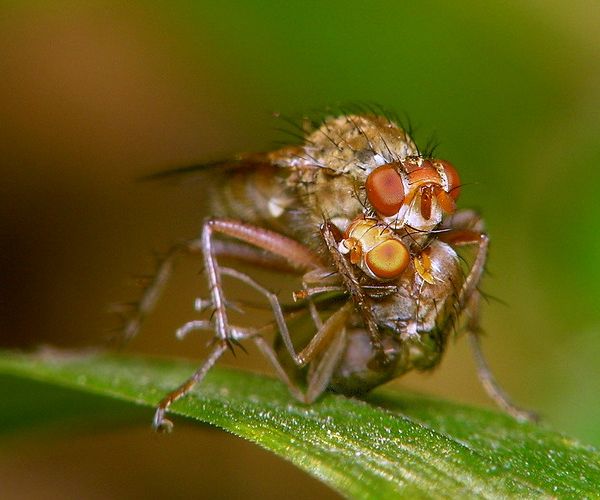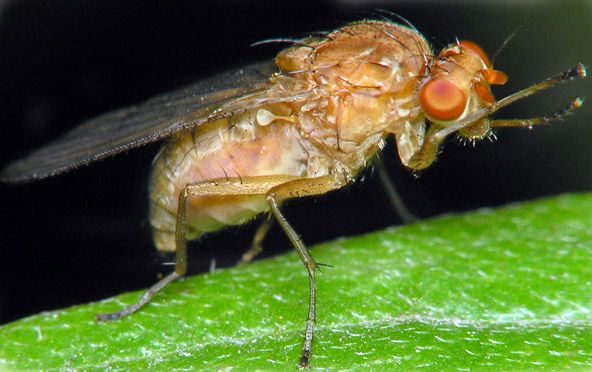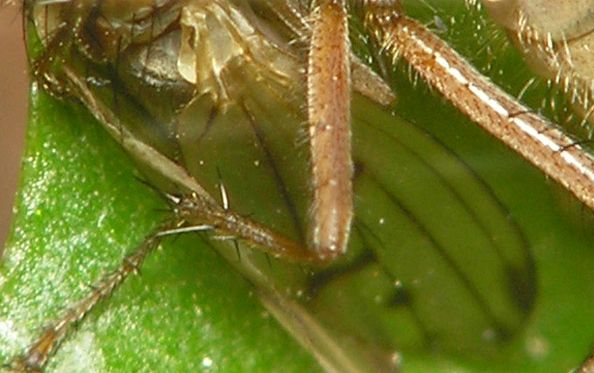Diptera.info :: Identification queries :: Diptera (adults)
Who is here? 1 guest(s)
|
Fly from Mr. Boren
|
|
| Nikita Vikhrev |
Posted on 01-12-2005 14:09
|
|
Member Location: Moscow, Russia Posts: 9336 Joined: 24.05.05 |
It is an image of Russian photorafer. Penza (Central European part of Russia), end of september. Boren and me agree that prey is Scathophaga (stercoraria?). Boren think that victim is also Scathophagidae. I think that victim looks rather like Opomyzidae. Who is right, please? 
Nikita Vikhrev - Zool Museum of Moscow University |
|
|
|
| Paul Beuk |
Posted on 01-12-2005 15:22
|
|
Super Administrator Location: Netherlands Posts: 19363 Joined: 11.05.04 |
No vibrissae, one reclinate orbital seta, strong proclinateocellar setae: You could be right with genus Opomyza but let's wait what Jan Willem thinks. One thing is certain: no Scathophagidae (or other Calyptrate for that matter).
Paul - - - - Paul Beuk on https://diptera.info |
| Kahis |
Posted on 01-12-2005 15:25
|
|
Member Location: Helsinki, Finland Posts: 1999 Joined: 02.09.04 |
Hi! The victim (prey) is not a scatophagid, but I cannot say for sure which family it belongs to. The predator is a scatophagid just as you say. Kahis |
| Jan Willem |
Posted on 02-12-2005 10:52
|
|
Member Location: Waalwijk, The Netherlands Posts: 2136 Joined: 24.07.04 |
As far as I can judge from the picture, it doesn't look like an opomyzid to me. |
|
|
|
| Kahis |
Posted on 02-12-2005 14:00
|
|
Member Location: Helsinki, Finland Posts: 1999 Joined: 02.09.04 |
My 'instant instinct' said Pallopteridae, but I cannot give a single reason why 
Kahis |
| Nikita Vikhrev |
Posted on 02-12-2005 15:14
|
|
Member Location: Moscow, Russia Posts: 9336 Joined: 24.05.05 |
1. Writing "victim" I meaned "prey", writing "prey" I meaned "predator", I'm sorry. Fortunely, you understood me anyway! 2. Paul, Kahis and Jan, thank you for your replies. 3. To Kahis: I didn't regard the possibility of Pallopteridae. I thought that 30.09 is too late for them. Nikita Nikita Vikhrev - Zool Museum of Moscow University |
|
|
|
| Jan Willem |
Posted on 02-12-2005 21:05
|
|
Member Location: Waalwijk, The Netherlands Posts: 2136 Joined: 24.07.04 |
Hi Nikita, I have to admit that I don't know which family the prey belongs to, but you shouldn't rule out Pallopteridae because of the date. It's not too late for them! Jan Willem |
|
|
|
| Nikita Vikhrev |
Posted on 02-12-2005 23:28
|
|
Member Location: Moscow, Russia Posts: 9336 Joined: 24.05.05 |
Hi Jan. Yes I shouldn't. But I used "past", it was selfexplanaition why the idea of Pallopteridae didn't come to my mind. And how easy to overlook probably right answer. After Kahis message I discovered that my own photo of Palloptera (venusta?) dated 24.09. So I have to be the last person to rule out Pallopteridae because of date 
Nikita Vikhrev - Zool Museum of Moscow University |
|
|
|
| Nikita Vikhrev |
Posted on 03-12-2005 12:20
|
|
Member Location: Moscow, Russia Posts: 9336 Joined: 24.05.05 |
Boren send me two more image of prey. It seems to me that there is strong costal spines. Heleomyzidae?  
Nikita Vikhrev - Zool Museum of Moscow University |
|
|
|
| Jan Willem |
Posted on 03-12-2005 13:18
|
|
Member Location: Waalwijk, The Netherlands Posts: 2136 Joined: 24.07.04 |
Hi Nikita, Are you sure both pictures are from the same species of prey? The first one certainly seems to have distinct (rather strong) bristles on the costa. These strong bristles are not present in Opomyza. The second picture, I have to admit, looks like a specimen of Opomyza florum to me. If the two specimens really belong to the same species then I have to admit that I seem to be making serious mistakes lately  . .The specimen on the first picture has distinctly darkened tarsi, which I have not seen in Opomyza florum for as far as I can recall. However differences in coloration of the legs between specimens of the same species is not al all uncommon in Opomyzidae (at least not in the genus Geomyza). Jan Willem |
|
|
|
| Nikita Vikhrev |
Posted on 03-12-2005 14:49
|
|
Member Location: Moscow, Russia Posts: 9336 Joined: 24.05.05 |
Hi Jan. As far as I understoot Boren (and I think that I understood him correct): 1. Scathophaga with prey. 2. Details 2.1. Up - The fly, victim in future - a minut before bieng captured by Scathophaga. 2.2. Down - Scathophaga legs under wing (with black crossveins) of victim. Nikita Vikhrev - Zool Museum of Moscow University |
|
|
|
| Nikita Vikhrev |
Posted on 03-12-2005 15:28
|
|
Member Location: Moscow, Russia Posts: 9336 Joined: 24.05.05 |
It is funny, but my main doubt against Kahis's theory was: it can't be Pallopteridae, otherwise Jan Willem "smell his family". After some addidional thinking I can tell - I eat my hat if it isn't Heleomyzidae! Nikita Vikhrev - Zool Museum of Moscow University |
|
|
|
| Paul Beuk |
Posted on 03-12-2005 23:39
|
|
Super Administrator Location: Netherlands Posts: 19363 Joined: 11.05.04 |
2.1 and 2.2 are not hte same species. I agree with Jan Willem (and everyone else) that 2.1 is Heleomyzidae (genus Suillia) and that the second one is Opomyza florum. The strong spines on the costa and setae on the legs seen in 2.1 are not present in 2.1 and 1, respectively. So 2.1 was NOT the furture prey!
Paul - - - - Paul Beuk on https://diptera.info |
| Nikita Vikhrev |
Posted on 04-12-2005 11:32
|
|
Member Location: Moscow, Russia Posts: 9336 Joined: 24.05.05 |
1. Realy, digital camera data show that time gap between 2.1. and 1. was 36 min, not 5 min. 2. Than thank you Paul and Jan, you were as usualy right, even with uncorrect question. Boren and me have to exuse for this unwilling mistification. Two flies look rather similar on first glance. 3. I hope that one day Boren will send to Diptera.info his images himself. He is a good photografer: http://macro.internity.ru/glr/displayimage.php?album=lastcom&cat=-23&pos=52 for example. Nikita Nikita Vikhrev - Zool Museum of Moscow University |
|
|
|
| Jump to Forum: |














